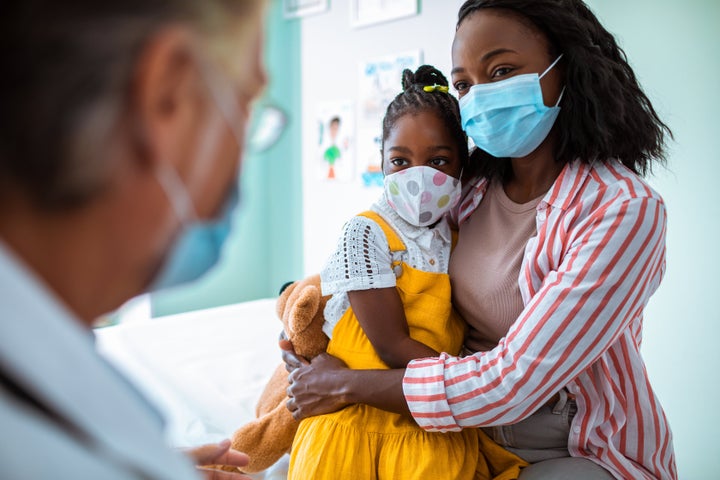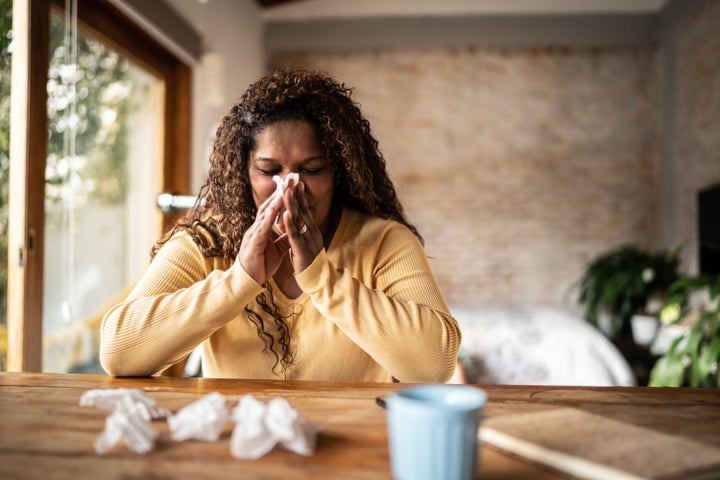
This fall is shaping up to be a bad season for viruses. The flu is spreading at a high rate, COVID-19 continues to kill more than 300 people on average every day and respiratory syncytial virus, or RSV, is surging.
Making things even harder, these viruses often appear the same in those they infect, with similar symptoms including sneezing, coughing, fever and more.
Not being able to tell what sickness you have makes these viruses even more dangerous. Certain illnesses are more concerning for some populations, and RSV in particular is dangerous for children (and it’s most common in children, too).
There are ways to detect RSV, including tests at your doctor’s office and also at-home tests. If you get tested, you’ll know for sure if you have this virus, which makes you better able to protect yourself and your loved ones. But symptoms can also give some indication. Experts shared with HuffPost the most common RSV symptoms in children, healthy adults and immunocompromised adults. Here’s what to know:
RSV is most common in children
“RSV is traditionally very scary for little kids less than 5, especially [those] less than 2,” said Dr. Purva Grover, medical director of the Cleveland Clinic’s pediatric emergency department. It’s a virus that can impact their respiratory system and their ability to breathe.
What’s different this year, though, is RSV is also appearing in children around ages 8 to 10. And it’s proving to be dangerous for children in this age group, which is something that was not seen before, Grover added.
For kids, irritability and loss of appetite along with sinus issues and cough are the biggest red flags
According to the Centers for Disease Control and Prevention, children infected with RSV may have a runny nose, congestion, cough, fever or a smaller appetite. In infants, irritability is a common symptom, along with a decreased appetite. These symptoms also won’t all happen at once ― they’ll occur at different times throughout the illness.
RSV is really common in children, it’s so common, in fact, that the CDC notes that “almost all children will have had an RSV infection by their second birthday.”
While many children get sick with RSV and recover fine, this is not the case for everyone. It becomes particularly concerning when kids are having a hard time breathing — like when they are wheezing or gasping for air ― which is often when parents bring them to the emergency room for treatment.
“Children come to the ER usually three to four days” after infection, Grover said. “The virus starts peaking, the viral load is the maximum at that time, and parents bring their kids in because of respiratory distress.”
Additionally, because children are breathing so fast to try and take in an adequate amount of air, they often end up dehydrated when suffering from RSV.
“They’re having a hard time drinking and whatever they’re drinking is being metabolized so quickly,” because of their frantic breathing, Grover said.
In immunocompromised adults, RSV symptoms can look like the flu and have the potential to progress to pneumonia
In adults, the most severe effects of RSV are often seen in immunocompromised people, said Dr. Cesar A. Arias, chief of the infectious diseases division at Houston Methodist Hospital and co-director of the Center for Infectious Diseases Research at Houston Methodist Research Institute.
People who fall into this category are generally undergoing chemotherapy, a recipient of an organ or bone marrow transplant, or are taking immunosuppressive drugs, Arias said.
In this situation, “the infection presents [with] flu-like symptoms but eventually progresses to pneumonia,” he said.
He added that pneumonia symptoms differ from person to person depending on how heavily they’re immunocompromised. “It could be a lot of [coughing] to a more severe presentation where the respiratory status is affected,” which means the infected person has trouble breathing.
People who are at high risk for developing severe disease and notice these dangerous symptoms are the ones going to the hospital for treatment, he noted.
He stressed that while you may not have cancer or may not be the recipient of an organ transplant, common chronic diseases like diabetes, advanced cardiac disease and COPD can still put you at higher risk for developing more severe RSV symptoms.
“Even a mild infection can kind of push you over the edge depending on your physiological reserve,” Arias said. If you have heart issues or lung problems, RSV could be difficult for your body to manage and could lead to heart attacks or other issues that are associated with the stress that respiratory infections put on your body.
Many adults with RSV will experience mild symptoms that mimic a sinus infection or a cold
If you are an adult with a healthy immune system, you probably don’t need to be too concerned about your own health if you become infected with RSV.
“We haven’t seen a worrisome train of increased hospitalization because of RSV in [non-immunocompromised adult] populations,” Arias said. But that doesn’t mean healthy adults aren’t getting sick and seeking medical attention from their primary care doctors.
For adults who are not immunocompromised, symptoms are generally mild and resemble a cold or sinus infection. RSV is an upper respiratory infection, so Grover says healthy adults can expect symptoms like a runny nose and congestion.
Adults should also keep an eye out for shortness of breath, chest pain and the inability to take deep breaths, which are all common signs of RSV, too, she said. Additionally, healthy adults can expect a low-grade fever, sore throat and cough, according to the Mayo Clinic.

In general, adults with a healthy immune system are able to ‘fight’ this virus, but that doesn’t stop transmission
Adults who are not immunocompromised can “fight” this virus because of their strong immune systems, so the symptoms will more than likely be pretty mild.
But, as made evident by COVID-19, “a sniffle for you could be OK, but [if spread], it could literally kill the little one and the older person,” Grover said. This is particularly the case for adults who may be the caregivers or loved ones of children or people with weakened immune systems.
Both Grover and Arias said in order to protect yourself and others, you should wear a mask in crowded spaces, stay home if you’re sick, practice good hand hygiene and make sure you’re up to date on your COVID-19 vaccination, particularly with the new bivalent COVID-19 booster, and have gotten your flu shot.
There’s no vaccine for RSV, though there are vaccines currently in development.
Arias noted that going to get tested if you have symptoms is also a good idea, as it can determine what kind of virus you have and the best treatment plan. There’s a three-in-one test that checks for flu, RSV and COVID-19.
It pays to be cautious as three highly contagious and potentially deadly viruses spread so rapidly. And in terms of RSV, “frankly, at this time I would consider everybody to be carriers,” Grover said.